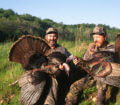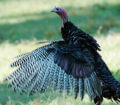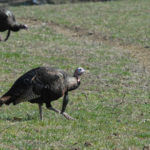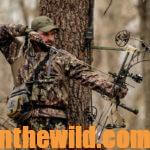Editor’s Note: Since some states’ turkey seasons continue through the first part of May, and others don’t end until May 31st or even in June, we’re looking this week at more ways to take turkeys. Often people trying to learn how to hunt turkeys go about it wrong. They try any-new method they hear about from anybody who ever has hunted turkeys, and they rely heavily on luck. But to become a successful turkey hunter, you must have confidence in your own skills.
Read books and magazines on turkey hunting, listen to lectures, and go to turkey-hunting seminars and calling contests. Pinpoint the places where turkeys like to roost, the movement patterns they most often follow and the times of day when they engage in various activities. Learn to identify the sounds they make, and understand what the different sounds mean. Too, find yourself a mentor: a successful, experienced turkey hunter who will take you under his or her wing. This person greatly can increase your knowledge and awareness of turkeys. Spend time in the woods listening to turkeys and looking at them before, during and after turkey season. Correlate what you’ve read, and what you’ve heard from other hunters with what you see in the woods.
* Learn to Read Sign:
After you understand what gobblers like to do, and where they like to do it, next you need to learn to read and interpret the sign they leave in the woods. Find turkey sign to choose a place to hunt. Turkey sign has a degree of permanence. Most tracks and droppings will last until the next rain, and feathers generally will last until the next year. The woods contain a record of what the turkeys have been doing, once you learn to see and identify that record.
 Go into the woods with an experienced turkey hunter. Let him show you the difference between turkey scratchings and places where squirrels have dug in the leaves for nuts. He can point-out turkey tracks and probably give you reasons why a turkey has walked in that particular area. He can spot turkey droppings and teach you the difference between hen and gobbler droppings. He can show you how to tell an old scratching from a new one. If you find a fresh track, you know the turkey shouldn’t be more than a mile away. And, the odds are he’ll be much closer than that. If the weather has been dry for several days, and you discover a soft dropping, you know the turkey is so close he may be looking at you.
Go into the woods with an experienced turkey hunter. Let him show you the difference between turkey scratchings and places where squirrels have dug in the leaves for nuts. He can point-out turkey tracks and probably give you reasons why a turkey has walked in that particular area. He can spot turkey droppings and teach you the difference between hen and gobbler droppings. He can show you how to tell an old scratching from a new one. If you find a fresh track, you know the turkey shouldn’t be more than a mile away. And, the odds are he’ll be much closer than that. If the weather has been dry for several days, and you discover a soft dropping, you know the turkey is so close he may be looking at you.
* Understand How to Call:
Good turkey callers have an ear for music and a knack for playing an instrument, even though that instrument may be a diaphragm caller, a cedar box or a slate and peg. To become an effective caller, listen to cassette tapes of actual turkey calls or of expert callers. Next, visit with some experts, and let them show you the finer points of calling. Go to turkey-calling contests, and listen to the calls the contestants make. Once you’ve learned to make the basic calls of turkeys, next develop confidence in your calling. To do that, you have to go out into the woods and begin to call. Remember, a turkey doesn’t walk around thinking, “Is that a man or a turkey making that call?” If a tom hears a noise that sounds like another turkey, he may go to it.
* Learn to Shoot:
Learning how and when to shoot is the final skill that a turkey hunter needs to develop. You need a quality gun and one in which you have confidence. Don’t use a gun that throws a 65-percent pattern at 40 yards, when you can buy one that throws an 85-percent pattern. Know the capabilities of your gun at various ranges. Then you won’t try to shoot farther than it can carry a tight pattern. Before you squeeze the trigger, you’ve got to know if you’re close enough to the turkey to make a kill. I recommend getting a turkey silhouette or s decoy, placing it in the woods, walking away from it and trying to judge the distance to it. Then check your accuracy with a range finder. Finally, practice shooting from awkward positions on the ground. A turkey often will walk up and force you to shoot from a strange position, off-balance or screwed-around.
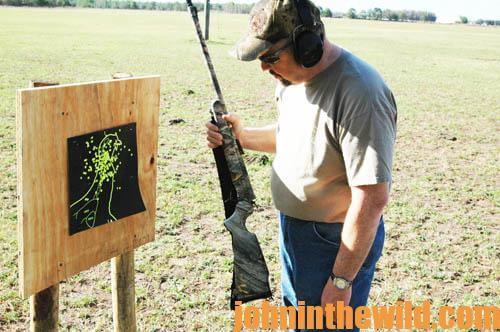 The best advice I can give a beginner on how to learn how to hunt turkeys is to start hunting. Sure, you’ll make some mistakes, but you’ll also learn from them.
The best advice I can give a beginner on how to learn how to hunt turkeys is to start hunting. Sure, you’ll make some mistakes, but you’ll also learn from them.
To learn more about turkey hunting, check out John E. Phillips’ print, Audible, Kindle and Nook turkey books at https://johninthewild.com/books/#turkey and at www.barnesandnoble.com. You also can download a free Kindle app that enables you to read the book on your iPad, computer or SmartPhone. You can learn more about calling turkeys by going to johninthewild.com/audio-files/ for audio turkey tapes to purchase of Lovett Williams, Rob Keck and Chris Kirby, available for download to your SmartPhone, tablet or computer. For a free copy of John E. Phillips’ “The Turkey Gobbler Getter Manual,” go to https://johninthewild.com/free-books/ to download.

